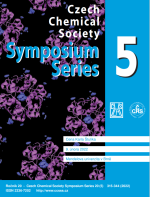Vliv podkladového materiálu a přídavku komplexačního činidla na galvanickou přípravu SERS-aktivních vrstev a spektra riboflavinu
DOI:
https://doi.org/10.54779/ccsss20220331Klíčová slova:
riboflavin, SERS spektroskopie, Ag substrát, galvanická depozice, podkladový materiál, EDTAAbstrakt
SERS spectroscopy remains not a well-established analytical technique mainly because of the complicated preparation of SERS-active substrates, which often have low reproducibility. For this reason, the development of new or optimization of existing substrates is important. For testing the SERS activity of these substrates, the so-called model analytes are commonly used. One of them is riboflavin, which is utilized for its non-toxicity and suitable optical properties.
This work is focused on optimizing the enhancing properties of galvanically prepared silver substrates. The influence of the base material (Al and its alloys, Zn) and of the addition of a complexing agent (EDTA) into the Ag deposition bath on the spectral response of riboflavin was evaluated. Each prepared substrate was characterized by scanning electron microscopy, and the SERS spectra were collected using an excitation wavelength of 1064 nm. All data were subsequently processed and interpreted using multivariate statistics, namely principal component analysis. The most universal and suitable base material for the preparation of Ag substrate for riboflavin detection was the AlMg alloy. The addition of a complexing agent to the deposition bath changed the morphology of the prepared substrates and the highest spectral response of riboflavin was obtained by adding 0.55 mM EDTA. The intensity of riboflavin spectral response was comparable to the value obtained using substrates prepared in the Ag bath, but the substrates prepared in the AgNO3 solution achieved a weaker enhancement of the spectral response.




